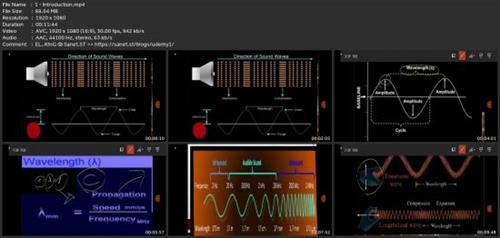
Published 8/2024
MP4 | Video: h264, 1920x1080 | Audio: AAC, 44.1 KHz
Language: English | Size: 1.58 GB | Duration: 3h 13m
Comprehensive for radiology teaching
What you'll learn
How sound waves interact with different tissues, including reflection, refraction, and scattering
In this course, students will gain a comprehensive understanding of ultrasound imaging, covering both the theoretical and practical aspects. They will learn
Fundamental Principles of Ultrasound: The basic physics of sound waves, including concepts like wavelength, frequency, speed, and intensity.
The characteristics of the ultrasound beam, including beam focusing and the factors that affect image resolution
The workings of ultrasound transducers and probes, including the piezoelectric effect.
Different imaging modes (A-mode, B-mode, M-mode) and how to use time gain compensation to improve image quality.
The Doppler effect and its application in measuring blood flow and velocity
Tissue harmonic imaging for enhanced image quality and the identification and interpretation of common ultrasound artifacts.
By the end of this course, students will be equipped with the knowledge and skills needed to understand the underlying principles of ultrasound
Requirements
There are no strict prerequisites for taking this course, but a basic understanding of the following will be helpful: Basic Physics: Familiarity with general physics concepts, particularly those related to waves and sound, will make it easier to grasp the technical aspects of ultrasound. Medical Terminology: A general understanding of medical terms will be beneficial, especially when discussing clinical applications and anatomy. Interest in Medical Imaging: A keen interest in learning about medical imaging technologies will enhance your learning experience. While prior experience with ultrasound is not required, being comfortable with scientific and technical concepts will help you get the most out of this course.
Description
Unlock the power of ultrasound imaging with this comprehensive course designed for medical professionals, students, and enthusiasts alike. Whether you're a radiologist, sonographer, or a medical student, this course will guide you through the intricacies of ultrasound, from basic principles to advanced applications.What You'll Learn:Fundamental Physics of Ultrasound: Grasp the core concepts of sound waves, including wavelength, frequency, speed, and intensity, and how they relate to ultrasound imaging.Ultrasound Technology: Dive deep into the mechanics of ultrasound transducers, probes, and imaging modes, and understand the piezoelectric effect that powers ultrasound devices.Imaging Techniques and Resolution: Explore the formation and focusing of the ultrasound beam, and master the concepts of axial, lateral, and temporal resolution to enhance image clarity.Advanced Ultrasound Applications: Delve into specialized topics such as Doppler imaging for blood flow analysis, tissue harmonic imaging for enhanced resolution, and the identification of common ultrasound artifacts.Why Take This Course?This course offers a structured and detailed learning experience, combining theoretical knowledge with practical insights. Each section is designed to build on the last, ensuring a cohesive and comprehensive understanding of ultrasound. By the end of this course, you'll be equipped with the skills and confidence to interpret ultrasound images accurately and utilize ultrasound technology effectively.Who Should Enroll?Medical professionals (radiologists, sonographers, clinicians) looking to deepen their expertise in ultrasound.Medical students, residents, and health science students eager to learn the fundamentals and advanced techniques of ultrasound imaging.Biomedical engineers interested in the technology behind ultrasound equipment.Anyone with a passion for medical imaging and a desire to understand how ultrasound is used in clinical practice.Prerequisites:While no prior experience with ultrasound is required, a basic understanding of physics and medical terminology will be helpful.Join this course and take your ultrasound skills to the next level. Whether you're a beginner or someone looking to enhance your existing knowledge, this course will provide you with the tools and insights needed to excel in the field of ultrasound imaging.
Overview
Section 1: IntroductionBasics of Ultrasound
Lecture 1 Introduction
Lecture 2 Wavelength, Frequency, Speed, Period of Sound
Section 2: Ultrasound physics
Lecture 3 Pressure, Intensity of Sound
Lecture 4 Pulse Echo Ultraso
Lecture 5 Acoustic Impedance
Lecture 6 Reflection of Ultrasound
Lecture 7 Refraction
Lecture 8 Scatter of Ultrasound
Section 3: Ultrasound Technology
Lecture 9 Pzo
Lecture 10 Damping
Lecture 11 Modes of Ultrasound
Lecture 12 Time Gain Compensation
Lecture 13 Types of Ultrasound Probes
Section 4: Ultrasound Beam and Resolution
Lecture 14 Ultrasound Beam
Lecture 15 Beam Focusing
Lecture 16 Axial Resolution
Lecture 17 Temporal Resolution
Lecture 18 Lateral Resolution
Section 5: Advanced Ultrasound Concepts
Lecture 19 Doppler shift
Lecture 20 Cw vs pw
Lecture 21 Ultrasound modes
Lecture 22 Tissue harmonic effect
Lecture 23 Ultrasound artifacts
Medical Professionals: Radiologists, sonographers, and other healthcare professionals who want to deepen their understanding of ultrasound imaging. Medical Students and Residents: Those in training who need a solid foundation in the principles and applications of ultrasound. Biomedical Engineers: Professionals interested in the technology and mechanics behind ultrasound equipment. Health Science Students: Individuals studying nursing, physiotherapy, or related fields where ultrasound is a valuable diagnostic tool. Anyone Interested in Medical Imaging: Individuals who are curious about how ultrasound works and its role in modern medicine. This course is suitable for both beginners and those with some experience in ultrasound, offering a structured learning path from basic concepts to advanced techniques.
Screenshots

rapidgator.net:
nitroflare.com:

 News
News